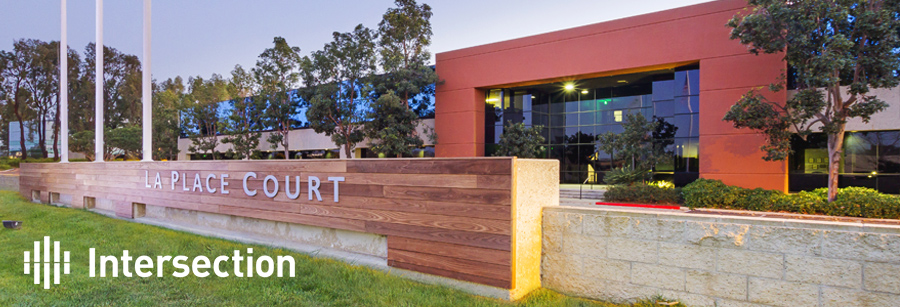The Second Acquisition in a Portfolio Delivering Strong Cash Flow for Investors
CARLSBAD, Calif. – San Diego based commercial real estate management and investment advisory firm Intersection announced the closing of escrow on La Place Court in Carlsbad on Feb. 12, 2020. The office property is the second procured by the company for the Intersection Diversified Value Fund (IDVF), which provides investors with a portfolio of properties that have in-place cash flow and high potential for appreciation.

La Place Court offers 81,965 square feet of office space on a 4.58-acre campus with two office buildings. Historically, the property has maintained a high occupancy, and as of closing, 90% of the property is leased.
Intersection acquired La Place Court from Swift Real Estate Partners, represented by Louay Alsadek, for approximately $15.8 million. Financing was completed by CBRE Capital Markets team Bill Chiles and Scott Peterson.
La Place Court is the second property in the IDVF, which is targeted to acquire $60 million in properties with approximately $25 million in equity according to Intersection Director of Acquisitions Dan Leon. The fund’s other property is Oberlin Court in Sorrento Mesa, which was acquired in May 2019.
“We feel that the risk adjusted returns for this product type are solid, especially given the continued strength of the Carlsbad submarket as indicated by increasing tenant demand from the technology sector, improving workforce talent, and strong demographics,” Leon said.
With this acquisition, Intersection officially plants their flag in Carlsbad, with plans to be a tenant of La Place Court providing on site brokerage and management services.
“Having ownership on site enhances the value of the property for investors,” said Intersection Senior Director Henry Zahner, who represented Intersection in the sale.
“By having a presence at La Place Court, we’ll be in a unique position to familiarize ourselves with both the property and its tenants,” said Zahner. “Furthermore, we will gain valuable insights in leasing remaining space.”
Leon added, “Being on site is all about the delivery of best-in-class service. It means being there for our tenants.”
Quality of service is a hallmark for Intersection, which is led by Rocco Cortese and Mark Hoekstra. With more than 60 years of experience in the real estate industry, Cortese and Hoekstra have built a customer-focused team that is providing investment, brokerage, and management Concierge services in the commercial real estate industry.
With this focus in mind, Intersection plans to modernize the property by integrating a seamless connectivity between indoor and outdoor working environments. Leon says this will create an innovative atmosphere at La Place Court, attracting a cohesive tenant mix that lays the groundwork for collaborative opportunities among tenants.
La Place Court promises to be a truly unique work setting that already offers tenants convenience and high-end amenities. Located in the prestigious Carlsbad Research Center, the facility boasts exceptional access to Interstate 5 and Highway 78. With the McClellan-Palomar Airport less than one mile away and being centrally located between San Diego and Orange County, the property provides an ideal hub for doing business in Southern California.
“By acquiring a high-end asset at below replacement cost, we’re providing investors with a portfolio that enhances short and long-term appreciation,” Leon said.
Opportunities to invest with Intersection will remain through 2020 as the team continues to secure properties and raise capital for the IDVF. Inquiries about the fund or investing can be sent via email to [email protected].
Dan Leon is the Director of Acquisitions, managing the performance of the funds and investments sponsored by Intersection. Contact Dan at 619-541-6070 or [email protected]